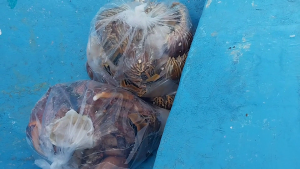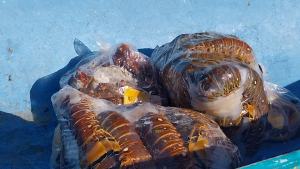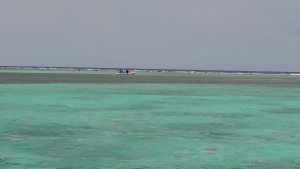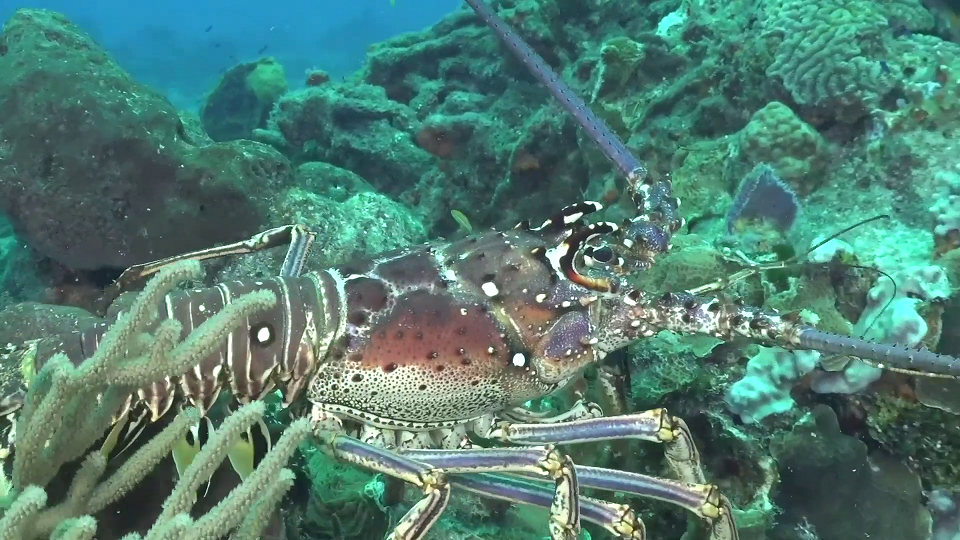Lobster Experts Say Lobster Stocks Near Coast Are Depleted First
Earlier this week, marine experts raised alarm about Belize’s lobster stocks being overfished, warning that without urgent action, this valuable resource could soon be depleted. A former fisheries officer, however, had a different take, suggesting that climate effects and boat interference might be to blame for the lobster scarcity in some areas. He also pointed out that there isn’t enough research yet to definitively say overfishing is the cause. But the fishermen we spoke with, along with lobster expert Doctor Daniel Pauly, disagreed. Here’s Part Three of the Lobster Stocks story by Marion Ali.
 Marion Ali, Reporting
Marion Ali, Reporting
Dr. Pauly debunks this theory and says there are indeed studies that have shown how and why lobsters disappear from certain areas, and it’s as simple as over-exploitation. That factor, Pauly says, has driven lobster stocks to the point of depletion in those areas.

Dr. Daniel Pauly
Dr. Daniel Pauly
“When a fishery begins, it is always the ones that are closer to the coast, closer to the cities, closer to the ports that are depleted first, that are fished first. Why? Because you have a low cost of transport with a boat and fuel costs and so on. So, it’s always like that, that in fisheries as the fishery develops, the fishers must go further off because the ones that were near are depleted, are gone. So, this is not because the animals move; this is because humans have removed the animals that were close, so you have to go further off. And anybody who tells you that the fish have moved, or the lobster have moved, this is the reason why they are not there anymore – anybody who says that doesn’t know anything about fisheries, because this is the strongest pattern that happens in fisheries.”
The Sea Around Us Initiative conducted its own independent research to bolster this position, and the results of the study were published in March of this year. In agreement with the data coming out of these research exercises (slides attached in Dr Pauly’s folder) are the findings of lobster expert, Dr Mark Butler. He shared information about how lobsters breed.

Mark Butler
Mark Butler, Lobster Expert
“Quite literally, the female produces an odor, a scent, that’s released into the water column. And that is what the males are then attracted to the females and come to find the females. But the mating process requires female acceptance.
They tend to mate sort of size-assorted. What that means is the smaller lobsters tend to mate with smaller lobsters. The bigger lobsters tend to mate with bigger lobsters. And one of the reasons for this, and a lot of our research has shown, is that, for example, if a small lobster mates with her, he cannot fertilize all her eggs because bigger lobsters produce more sperm to fertilize than do small lobsters. So big females have to have a big male to mate with.”
 After the male transfers the sperm in a black packet on the underside of the female, she releases her eggs and scratches the tar spot open, which releases the sperm from the packet. She fertilizes her eggs, and they attach to her tail for approximately three weeks while they develop. During that time, the female lobsters take care of the eggs, grooms them and oxygenates them and releases them, usually further offshore, since larvae can’t survive in inshore waters. The eggs travel in the sea ocean for about 7 months and go through 24 stages. Depending on ocean currents, the last larvae stage called the perilous post larvae can literally smell the inshore and come in at night on a flood tide around the new moon. They seek inshore habitats in shallow waters that have algae, mangroves and rocks. This is why Butler says it is important for the Fisheries Department to protect these areas, to give the baby lobsters a chance to mature and reproduce. The maturation stage takes 18 to 24 months before they can reproduce. Lobsters reproduce every year and can live up to about 15 years, once they are not caught.
After the male transfers the sperm in a black packet on the underside of the female, she releases her eggs and scratches the tar spot open, which releases the sperm from the packet. She fertilizes her eggs, and they attach to her tail for approximately three weeks while they develop. During that time, the female lobsters take care of the eggs, grooms them and oxygenates them and releases them, usually further offshore, since larvae can’t survive in inshore waters. The eggs travel in the sea ocean for about 7 months and go through 24 stages. Depending on ocean currents, the last larvae stage called the perilous post larvae can literally smell the inshore and come in at night on a flood tide around the new moon. They seek inshore habitats in shallow waters that have algae, mangroves and rocks. This is why Butler says it is important for the Fisheries Department to protect these areas, to give the baby lobsters a chance to mature and reproduce. The maturation stage takes 18 to 24 months before they can reproduce. Lobsters reproduce every year and can live up to about 15 years, once they are not caught.
 Back out on the patrol, the team searched the two fishing camps, but nothing illegal materialized. They pressed on, looking for more boats returning with their catch for the day. There was none that afternoon. The Ministry of the Blue Economy and the Belize Fisheries Department provided us with data that shows the most recent statistics on lobster tail production. Their slides show that the production of lobster tails increased over the past 22 years and claim that in 2001, Belize produced 440,000 pounds of tails for export, while in 2023, the figure increased to 636,877 pounds. This converts to US $11.7 million in export revenues, though the government did not explain the methodology upon which their results are based.
Back out on the patrol, the team searched the two fishing camps, but nothing illegal materialized. They pressed on, looking for more boats returning with their catch for the day. There was none that afternoon. The Ministry of the Blue Economy and the Belize Fisheries Department provided us with data that shows the most recent statistics on lobster tail production. Their slides show that the production of lobster tails increased over the past 22 years and claim that in 2001, Belize produced 440,000 pounds of tails for export, while in 2023, the figure increased to 636,877 pounds. This converts to US $11.7 million in export revenues, though the government did not explain the methodology upon which their results are based.
On the afternoon we accompanied the team, and it did not find any undersized lobster during their raids and searches. Belize’s revised fisheries law stipulates that for every undersized lobster tail found, there is a fine of a minimum of $50 per tail, along with a minimum of $1,000 for fishing for undersized commercial species. Marion Ali for News Five.
Belize Federation of Fishers Advisor Concerned Over Lobster Population







Facebook Comments